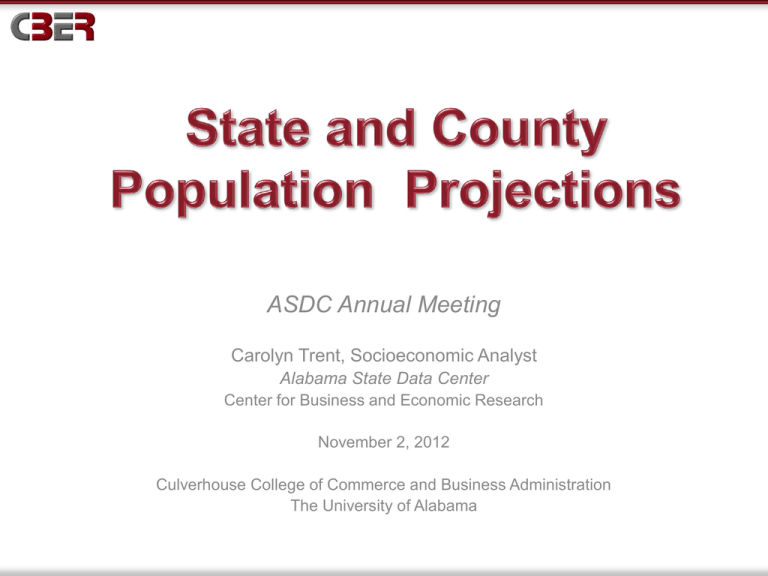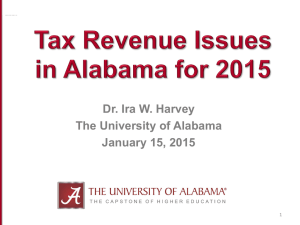
ASDC Annual Meeting
Carolyn Trent, Socioeconomic Analyst
Alabama State Data Center
Center for Business and Economic Research
November 2, 2012
Culverhouse College of Commerce and Business Administration
The University of Alabama
Based on population change between the 2000
and 2010 Censuses and recent birth and death
data. Assumptions are made about future trends
in fertility and mortality.
Utilize a cohort component model of the form:
Pop(new) = pop(old) + births – deaths
+ in-migration – out-migration
Calculated for the state and counties for 5-year
age groups from 0-4 to 80-84 and 85+, for
males/females, races white/black and other.
Alabama State Data Center | Center for Business and Economic Research, The University of Alabama
2
For the state and each county, the following are
compiled:
Population by age/race/sex for 2000 and 2010.
Total number of births by race of mother and sex of
child for 2000 through 2010 (from Alabama Center
for Health Statistics).
Total number of deaths by race, sex, and age group
for 2000 through 2010 (from ACHS).
Census 2000 and 2010 group quarters populations.
Alabama State Data Center | Center for Business and Economic Research, The University of Alabama
3
We use bridged-race population estimates from NCHS
instead of raw Census data.
These data are calculated by the Census Bureau for NCHS
annually to create race categories that are more compatible
with race information collected on state vital records.
Collapses the 31 race categories collected in the Census into 4
categories: White, Black or African American, American Indian
or Alaska Native, and Asian or Pacific Islander.
The NCHS groupings reallocate the multiple race and some
other race Census categories. Hispanics often identify
themselves as some other race.
Census 2010 data have Alabama with 3,275,394 white and
1,504,342 black and other residents. The bridged 2010 data
give 3,399,975 white and 1,379,761 black and other residents.
Alabama State Data Center | Center for Business and Economic Research, The University of Alabama
4
Using annual birth data by race of mother and
sex of child for 2000 to 2010, we calculate the
following for the state and each county:
General fertility rate by race for women aged 15 to 44
in 2010, using average births from 2006 to 2010.
Birth rate adjustment factors by race for each 5-year
period, based on factors calculated by the Census
Bureau for their most recent national projections.
Share of births by race that are male versus female,
based on all births from 4/1/2000 to 4/1/2010.
Alabama State Data Center | Center for Business and Economic Research, The University of Alabama
5
We begin with annual death data by 5-year age
groups, race, and sex for 2008 to 2010 for the
state and each county and calculate:
A one-year mortality rate for each age/race/sex
category by averaging the three years of deaths and
dividing by the 2010 population. These are converted
to multi-year rates.
Mortality adjustment factors for each 5-year period,
using actuarial tables from the Social Security
Administration.
We substitute in state rates for cells with fewer than 5
deaths on average.
Alabama State Data Center | Center for Business and Economic Research, The University of Alabama
6
Populations of people in prisons, colleges or
universities, or other large institutions are not
influenced by the usual demographic factors.
For 18 Alabama counties where at least 2.4
percent of the total population lived in group
quarters, special populations were estimated for
2000 and 2010 by age, race, and sex.
These populations were held constant across the
projection period.
Fertility rates were adjusted in counties with large
university populations.
Alabama State Data Center | Center for Business and Economic Research, The University of Alabama
7
The cohort-component program is run separately for each geography,
generating projections for 5-year intervals from 2015 to 2040.
The cohort aspect of the projection process is that the population in
each 5-year age group is aged over the 10-year intercensal period—
i.e., individuals who were 20-24 in 2000 will be 30-34 in 2010.
The unknown part of the projection is migration rates, which are
derived as the residual of the change from 2000 to 2010 after adding
births to the 2000 base population and subtracting deaths.
Migration rates are dampened for each 5-year projection period
under the assumption that the rate of people leaving a county will
slow over time as will the rate of individuals moving in.
In this new series of projections, county results are summed across
all age/race/sex groups to derive the state totals.
Alabama State Data Center | Center for Business and Economic Research, The University of Alabama
8
How will Alabama’s population
be changing?
Alabama State Data Center | Center for Business and Economic Research, The University of Alabama
9
Source: U.S. Census Bureau.
Alabama State Data Center | Center for Business and Economic Research, The University of Alabama
10
Alabama Population by Age Group
2010 and Projected 2025 and 2040
2010
2025
2040
Age Group
Number
Percent
Number
Percent
Number
Percent
0-4 years
304,957
6.4
307,591
5.9
324,612
5.8
5-19 years
971,355
20.3
998,297
19.0 1,004,970
18.1
2,845,632
59.5 2,925,619
55.8 3,037,589
54.6
65+ years
657,792
13.8 1,010,916
19.3 1,199,853
21.6
85+ years
75,684
20-64 years
Total
4,779,736
1.6
94,122
100.0 5,242,423
1.8
165,041
3.0
100.0 5,567,024
100.0
Source: U.S. Census Bureau and Center for Business and Economic Research, The University of Alabama.
Alabama State Data Center | Center for Business and Economic Research, The University of Alabama
11
Alabama Total Population 2000 and 2010
85+
85+
80-84
2010
80-84
75-79
2000
75-79
70-74
70-74
65-69
65-69
60-64
60-64
Age Groups
55-59
55-59
50-54
50-54
45-49
45-49
40-44
40-44
35-39
35-39
30-34
30-34
25-29
25-29
20-24
20-24
15-19
15-19
10-14
10-14
5-9
5-9
0-4
10.0
8.0
0-4
6.0
4.0
2.0
0.0
2.0
4.0
6.0
8.0
10.0
Percent by Age Group
Alabama State Data Center | Center for Business and Economic Research, The University of Alabama
12
Alabama Total Population 2010 and 2025
85+
85+
80-84
2025
80-84
75-79
2010
75-79
70-74
70-74
Age Groups
65-69
65-69
60-64
60-64
55-59
55-59
50-54
50-54
45-49
45-49
40-44
40-44
35-39
35-39
30-34
30-34
25-29
25-29
20-24
20-24
15-19
15-19
10-14
10-14
5-9
5-9
0-4
10.0
8.0
0-4
6.0
4.0
2.0
0.0
2.0
4.0
6.0
8.0
10.0
Percent by Age Group
Alabama State Data Center | Center for Business and Economic Research, The University of Alabama
13
Alabama Total Population 2025 and 2040
85+
85+
80-84
75-79
75-79
70-74
2025
70-74
65-69
65-69
60-64
60-64
55-59
Age Groups
2040
80-84
55-59
50-54
50-54
45-49
45-49
40-44
40-44
35-39
35-39
30-34
30-34
25-29
25-29
20-24
20-24
15-19
15-19
10-14
10-14
5-9
5-9
0-4
10.0
8.0
6.0
0-4
4.0
2.0
0.0
2.0
4.0
6.0
8.0
10.0
Percent by Age Group
Alabama State Data Center | Center for Business and Economic Research, The University of Alabama
14
Alabama Population by Race
2000 to 2010 and Projected 2025 and 2040
Total
White
Percent
Change
Number
Percent
Change
Black and Other
Percent
Number Change
Year
Number
2000
4,447,100
3,218,218
1,228,882
2010
4,779,736
7.5 3,399,975
5.6 1,379,761
12.3
2015
4,943,866
3.4 3,487,124
2.6 1,456,742
5.6
2020
5,101,172
3.2 3,568,000
2.3 1,533,172
5.2
2025
5,242,423
2.8 3,637,059
1.9 1,605,364
4.7
2030
5,365,245
2.3 3,694,126
1.6 1,671,119
4.1
2035
5,471,880
2.0 3,742,196
1.3 1,729,684
3.5
2040
5,567,024
1.7 3,785,415
1.2 1,781,609
3.0
Source: U.S. Census Bureau and Center for Business and Economic Research, The University of Alabama.
Alabama State Data Center | Center for Business and Economic Research, The University of Alabama
15
Economic development successes, local
entrepreneurship, quality of life enhancements, retiree attraction, and workforce
skills training could improve these trends
Alabama State Data Center | Center for Business and Economic Research, The University of Alabama
16
31 Alabama counties lost
population between 2000
and 2010.
Population change
between censuses
ranged from a gain of
36.1 percent in Shelby
County down to a loss of
16.1 percent in Lowndes
County.
Alabama population
growth was 7.5 percent.
Alabama State Data Center | Center for Business and Economic Research, The University of Alabama
17
Most projected growth
from 2010 to 2040 will
occur in metro area
counties.
Out-migration and aging
will contribute to
continued losses in rural
counties.
Alabama’s population is
forecasted to increase
16.5 percent.
Alabama State Data Center | Center for Business and Economic Research, The University of Alabama
18
CBER can calculate population projections for areas down
to the block group level. These are done on a contract
basis.
Change between the two most recent censuses is used as
a starting point.
A variety of other information, including building permits,
infrastructure development, and recent or upcoming
economic development are collected for the geographies
to be projected.
ACS data, such as age of housing stock and income
levels, is also used. Land area and housing density are
examined.
CBER small area projections have been used for regional
transportation plans and in socioeconomic impact studies
for highway projects.
Alabama State Data Center | Center for Business and Economic Research, The University of Alabama
19
Projections are posted to CBER website
http://cber.cba.ua.edu
under Data, Maps, and Presentations.
They can also be accessed from the ASDC
site’s Data section.
Detailed age/race/sex projections will not be
posted due to their size, but will be available on
CD from CBER for purchase.
Thank you!
Alabama State Data Center | Center for Business and Economic Research, The University of Alabama
20








